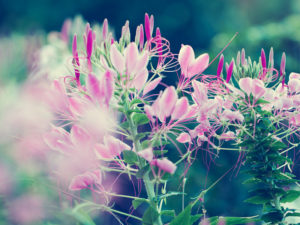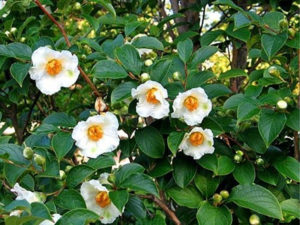The Lilium martagon is an ornamental plant native to hilly Switzerland and has vastly spread around the woodlands of Europe and Asia. This plant belongs to the lily family (Liliaceae), and it has been given the scientific name Lilium martagon.
Lilium martagon is also known as Turk’s Cap Lily, Balkan martagon lily, Mountain lily, Martagon lily.
The Lilium martagon is a majestic plant characterized by its striking fragrance and the production of lots of small, downfacing, stem-grown blooms. If you are looking for a plant that will make a great display in vases and as a cut flower, then this is a wonderful flower.
Lilium Martagon is a plant that is extremely easy to grow, that lasts for years once settled. This plant is self-fertile making it quickly multiply over the years too.
| Scientific Name | Lilium martagon |
| Hardiness | Hardy |
| Indoor or Outdoor Plant? | Indoors or outdoors |
| Sun Exposure | Full Sun, Partial Sun, Sheltered Sun |
| Water | 200 ml approximately every 9 or 10 days |
| Size | 2 to 5 feet (60 to 150 cm) and spread between 0.1 to 0.5 meters. |
| Soil Type | Tolerates most soil types moist and Well-drained |
| Soil pH | Neutral, Acid |
| Flower | From June to August White, Pink/Rose, Purple/Lavender, Red/Maroon, Orange/yellow |
| Growing Difficulty Level | Very easy to grow |
Lilium Martagon Appearance and Characteristics
Lilium Martagon is a very hardy, perennial plant (Martagon lily lasts for years).
The Lilium Martagon is a deciduous plant, and they lose their leaves annually when matured with dense, narrow foliage.
You can expect the Lilium Martagon to grow upright, hairy stems, with dense, dark green foliage reaching a height of about 1.2feet (4 feet approx.).
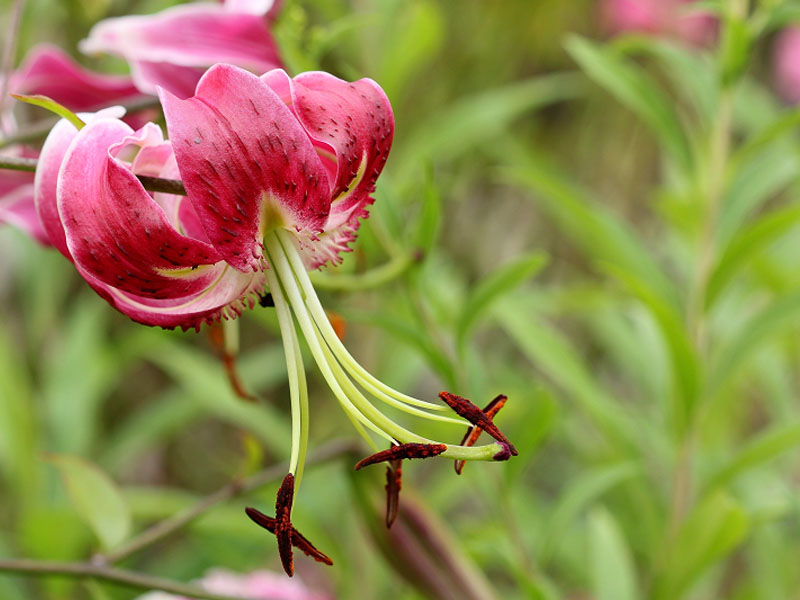
The Lilium Martagon plant doesn’t spread widely.
The Lilium Martagon produces small blooms from June to August.
These plants give gardeners stunning flowers of about 5cm long that grow downfacing, trumpet-shaped, or Turk’s cap-shaped (hence its common name) with suspended orange anthers.
The blooms in the Lilium Martagon plant are vibrant colors ranging from pink/rose, purple/lavender, red/maroon, and orange/yellow with several tiny freckles on their glossy, thick reflexed petals.
However, the Lilium Martagon “Album” is a spotless variety of white flowers.
Typically, the Lilium Martagon plant blooms in the early to middle of summer and generates between 12 and 30 flowers on average per stem.
It is not uncommon to find some plants producing up to 50 Lilium martagon blooms per stem too.
Lilium martagon is seriously toxic to cats. The consumption of Lilium martagon causes lethal kidney failure.
Lilium Martagon Growing Guide
Lilium Martagon is a plant that is easy to grow and, when well established, does so vigorously.
There are different ways to plant Lilium Martagon, such as from seeds, bulbs, or scales.
The Lilium martagon can be planted in containers or directly in the soil.
Lilium martagon demands plenty of sun and moisture, so a good layer of mulch will help the plant keep cool and grow healthy.
The martagon lily needs well-drained soil too.
However, the Lilium martagon plants should be kept moist but not overflowing in water.
The soil should be slightly acidic to guarantee the excellent production of martagon lilies.
The Lilium Martagon bulbs should be planted deep in the soil in about 10 to 15cm (4 to 6 inches approx.), or multiply by 3 according to the length of the bulb.
Plant the martagon lily bulbs in groups of three or four, and with at least 20 to 25 cm (8 to 10 inches approx.) space between plants.
Do this in two steps:
- Drill the soil at least 8 inches (20 cm) deep. To help the soil drain well, put a thick layer of pebbles or gravel about 5 cm (2 inches approx.)
- Put a layer of soil mixed with a bit of sand. This second layer should also be about 5 cm (2 inches approx.) thick.
- Plant the Lilium martagon bulbs.
- Cover with some more of the same mixed soil.
- Put some light pressure down onto the top soil to make it compact.
- When the Lilium martagon blooming period has finished, the flowers will wilt. You can leave the martagon lily in the soil for future blooms or remove the whole Lilium martagon plant and get it ready for another planting season.
If you decide to remove the Lilium martagon plant from the soil, clean the dirt attached to it when you remove it and spray some fungicide to avoid mold growth.
Put the martagon lily bulb in a container, covering it with a thin layer of soil.
Wrap the container with some paper and store it in a cool, dark, and dry place. The Lilium martagon bulb will dry and will be ready to be planted again.
Leaving the Lilium martagon bulbs in the soil is a much better approach so the plant can adapt to the soil through the seasons.
However, it is recommended to remove the bulbs at the end of three or four year period to renew the soil and bulbs.
Tip: Plant the Lilium martagon from seeds in containers between spring (after the last frost) and fall.
- Soak the seeds in water for one day before sowing them.
- Sow the seeds of martagon lilies at a depth of 6 mm (a quarter of an inch approx.) in moist, organic-rich soil in a small container or plastic bag.
- You will only see change about four weeks later, where there will be the formation of mini Lilium martagon bulbs or bulblets. Place the small container or plastic bag in the fridge for about three months more.
- Take the container or plastic bag out of the fridge and transplant it into a pot. It will take one to eight weeks for the seeds to germinate. Grow your Lilium martagon bulbs indoors for one year. It will take a while before seed-grown lilies bloom, and you may even be waiting up to four years.
Water
The Lilium Martagon doesn’t need much water.
However, you should not let it dry out. The soil should always be moist.
Water your Lilium Martagon with about 200 ml of water approximately every nine or 10 days.
Adjust watering after hot days.
The easier way to check if the soil is dry and your Lilium Martagon plant needs watering is by sticking your finger into the soil for about 2inc (5cm approx.) deep.
Water your plant to the soil level when it is dry, and stop watering if it is still moist.
Avoid overwatering as it will cause bulb rot.
Light
Although the Lilium Martagon plants demand full sun and will struggle to perform without generous sunlight, all martagon lily varieties enjoy a light portion of shade each day.
The perfect combination for the Lilium martagon to thrive is in the sun in the early hours and in the shade in the afternoon.
Soil
The martagon lily varieties need moist and well-drained soil.
The Lilium martagon plants crave slightly acidic soil with pH levels of 5.5 to 6, and they benefit from a touch of lime every year in the soil too.
Mulching in spring is key to keep the soil moist in a warmer climate.
Temperature and Humidity
The Lilium martagon is a hardy plant and can stand freezing temperatures of -30F (-34C).
The ideal temperatures are 70F (21C approx.).
The Lilium martagon blooms in from early to midsummer (June – August, depending on where you live).
Potting and Re-potting
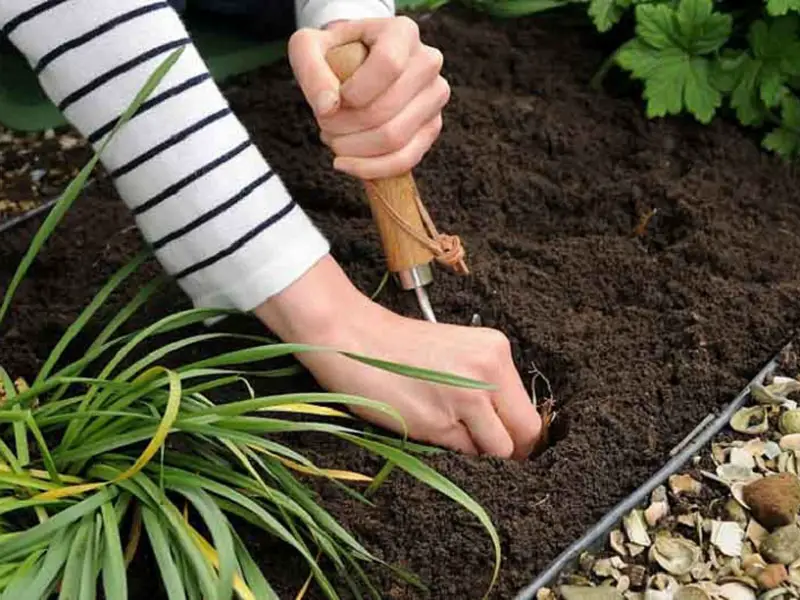
Planting martagon lily in containers is a showstopper in your garden or patio.
However, to succeed in the process, you must consider the size of the planter or container.
The Lilium martagon will require a rather bigger planter.
The Lilium martagon has a tall and thin stem and can reach a height between 2 to 5 feet (60 to 150 cm) after maturity in about two to five years.
The Lilium Martagon spread between 0.1 to 0.5 meters.
It is important to renew the martagon lily’s nutrients by repotting it once it has doubled its size or every year if you prefer, depending on the plant’s growing conditions.
Grow Lilium martagon seedlings in individual pots, then repot them when they have reached a big enough size to be carefully potted in bigger containers or out in the soil directly.
Propagating and Pruning
The Lilium martagon plants can be propagated by different methods such as seeds, bulbs, or bulbils (bulb scales).
Propagating Lilium Martagon using bulbs is much more advisable as they grow and produce blooms quicker.
The process for propagating Lilium Martagon is simple, and it is the same with whatever method you would like to use.
Start the process of sowing the Lilium martagon between spring and early autumn.
Clear the soil of weeds, do it by pulling them by hand or with a small shovel or hoe.
Loose the soil with the help of a garden fork and rake it to make it smooth and even.
Drill a shallow hole; you can use a stick for it. Drill in random directions.
Think how you would like your Lilium martagon to be displayed when they start growing.
Top Tip: Some people like “drawing” swirls-like rows when drilling the holes.
Water the holes as you drill.
Always space out the martagon lily plants when planting, taking into consideration the final size of the plant according to the variety of the martagon lilies seeds you are planting.
Put back a thin layer of soil to cover your Lilium martagon seeds.
Firm the soil gently.
It’s a good practice to label your plant; this is so you know what Lilium martagon variety you have sown and date, so you know when to expect blooms to appear.
Water the soil once more time to maintain it moist.
Avoid overwatering as this will result in bulb rot.
After the blooming period has finished, cut back the yellow leaves and dried stems of your Lilium martagon; by then, your plant might have self-seeded.
The Lilium martagon plants require no pruning at all.
All you need to do is to remove those leaves that have fallen on the soil and cut the stems under the wilted, dry flowers.
Advantages of Growing Lilium Martagon Plants
These Martagon lilies perform well in flowerbeds, borders, containers to give a cottage look to your garden and flower arrangements.
Lilium Martagon is a very easy-to-maintain plant, which is what makes them so popular.
The uses of Lilium Martagon plants are not just for ornamental purposes.
Alternative medicine uses them to treat migraines and toothaches as well as to treat different kinds of burns.
Lilium Martagon Pests, Diseases, and Problems
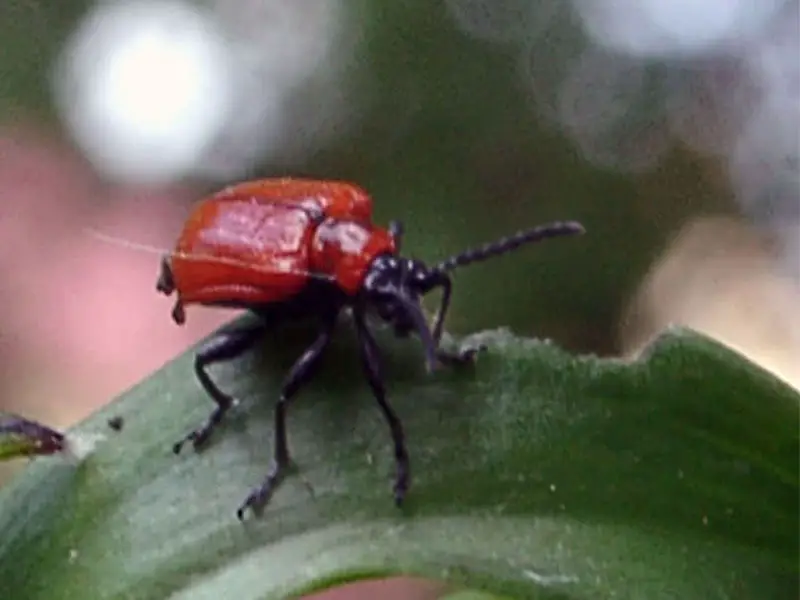
Although Lilium Martagon is a pests and diseases free plant; however, there are a few culprits you need to watch for.
The Lilium martagon plants are targeted by aphids, lily beetle, slugs, snails, and wireworms, and some of the containers planted martagon lilies are affected by vine weevil too.
The Lilium Martagon plants can be affected by grey mold, which attacks the young leaves.
Lilium Martagon Seeds
Apart from the weather conditions, well-prepared soil, and water, the quality of the seeds plays a very important role in guaranteeing a blooming garden.
Commonly small Lilium martagon seeds should be planted in shallower soil to just be sprinkled on the soil surface.
If small seeds of Lilium martagon are sown deeply in the soil they will not germinate.
Check seed packets and follow the instructions on how deep the seeds should go when sowing.
Get the seeds from a trusted supplier or check out these useful links:
FAQs
Are Lilium martagon plants edible?
The Lilium martagon bulbs are edible; however, their taste is rather bitter.
You won’t be surprised to find the Lilium martagon being used in Japanese cuisine, including the Lilium martagon bulb as an ingredient in their Chawan-mushi egg custard dish.
Note: The flowers of the Lilium martagon plants are highly toxic to cats.
I have a small garden, can I plant Lilium Martagon?
Lilium Martagon plants are very easy to grow in the ground, and they look amazing in raised beds in your garden or patio containers too.
The blooms and the actual plant of the Lilium Martagon are smaller than other types of lilies, so it makes the martagon lily a garden favorite, not to mention the great display as a cut-flower too.



